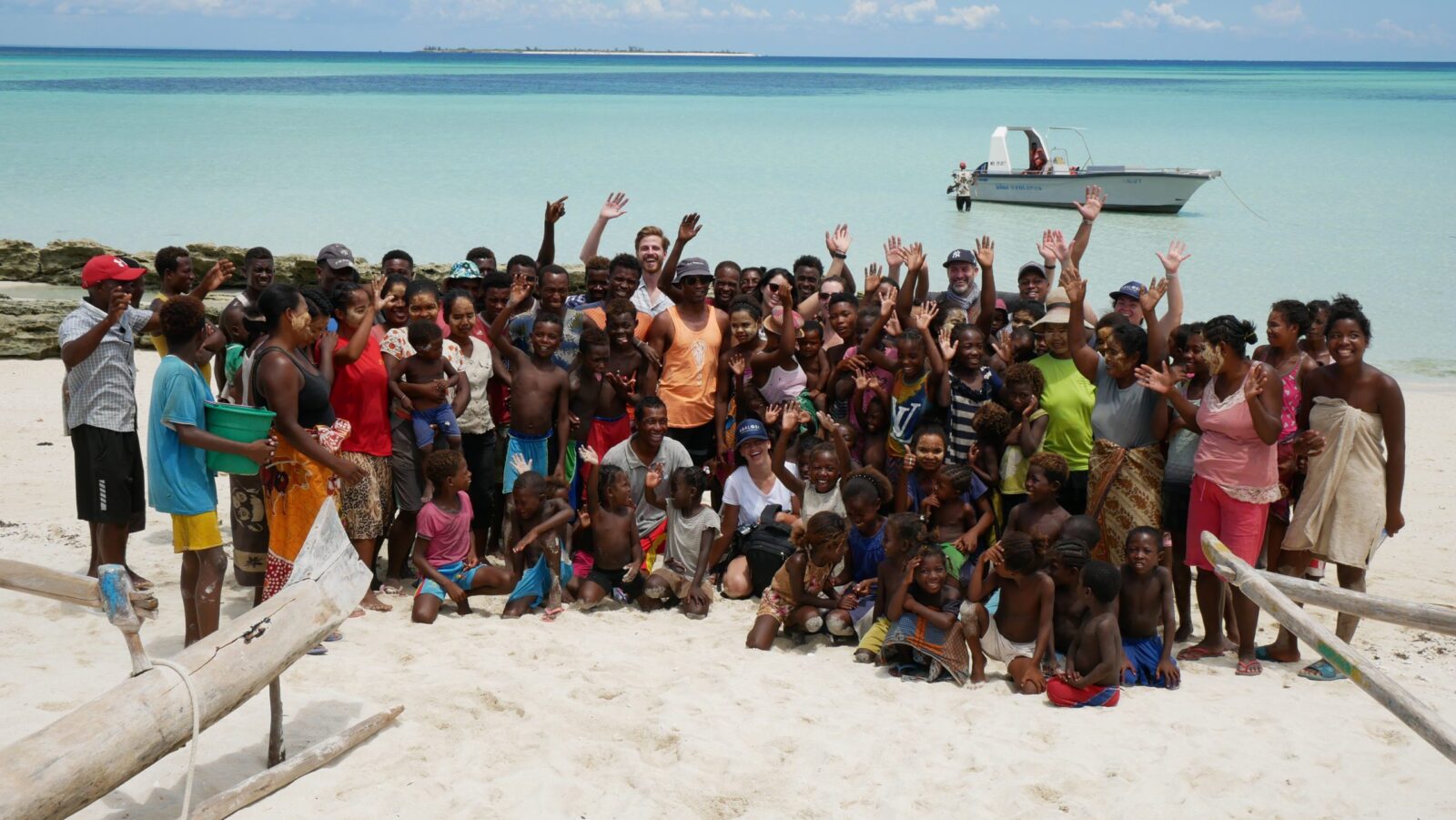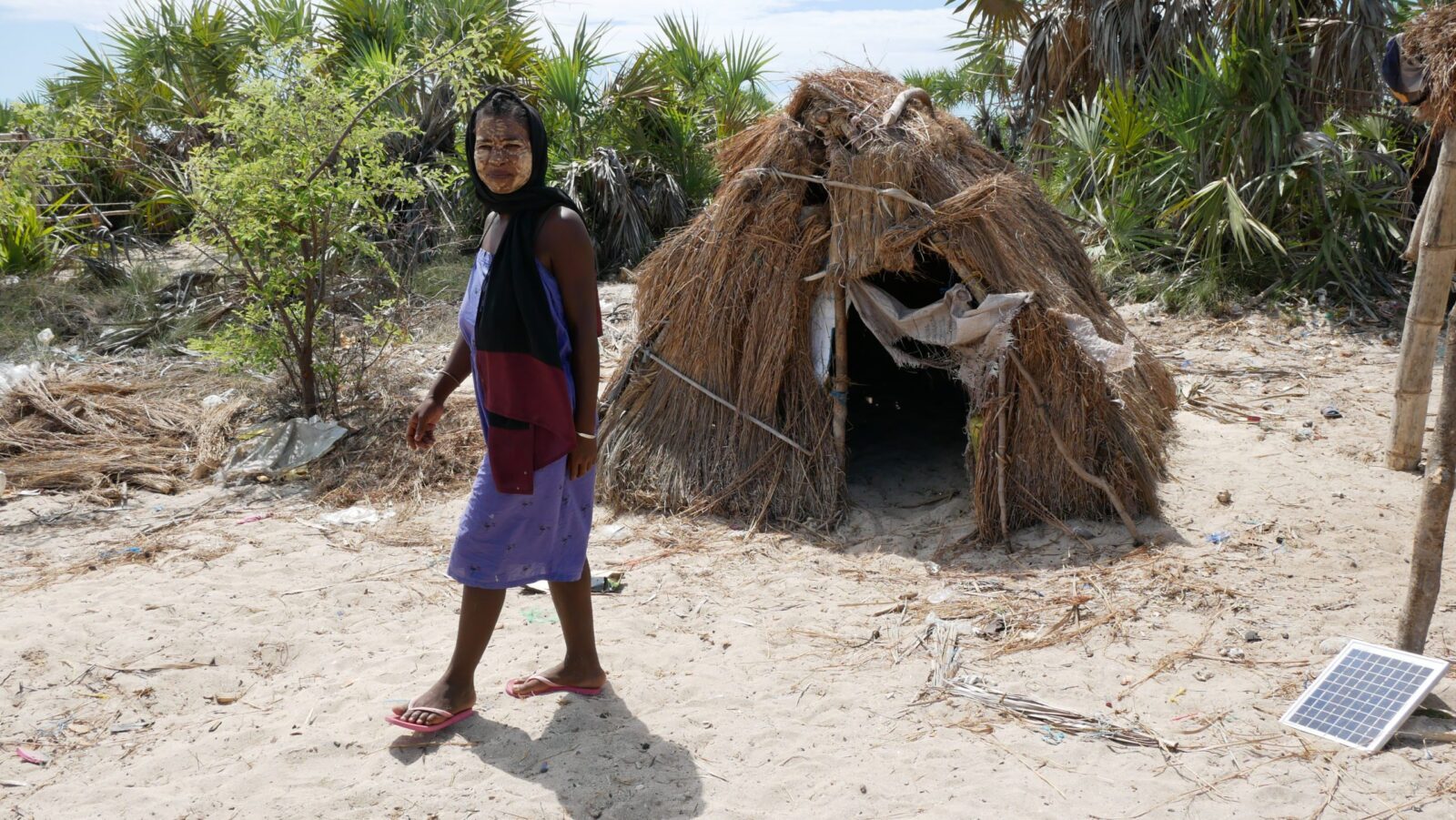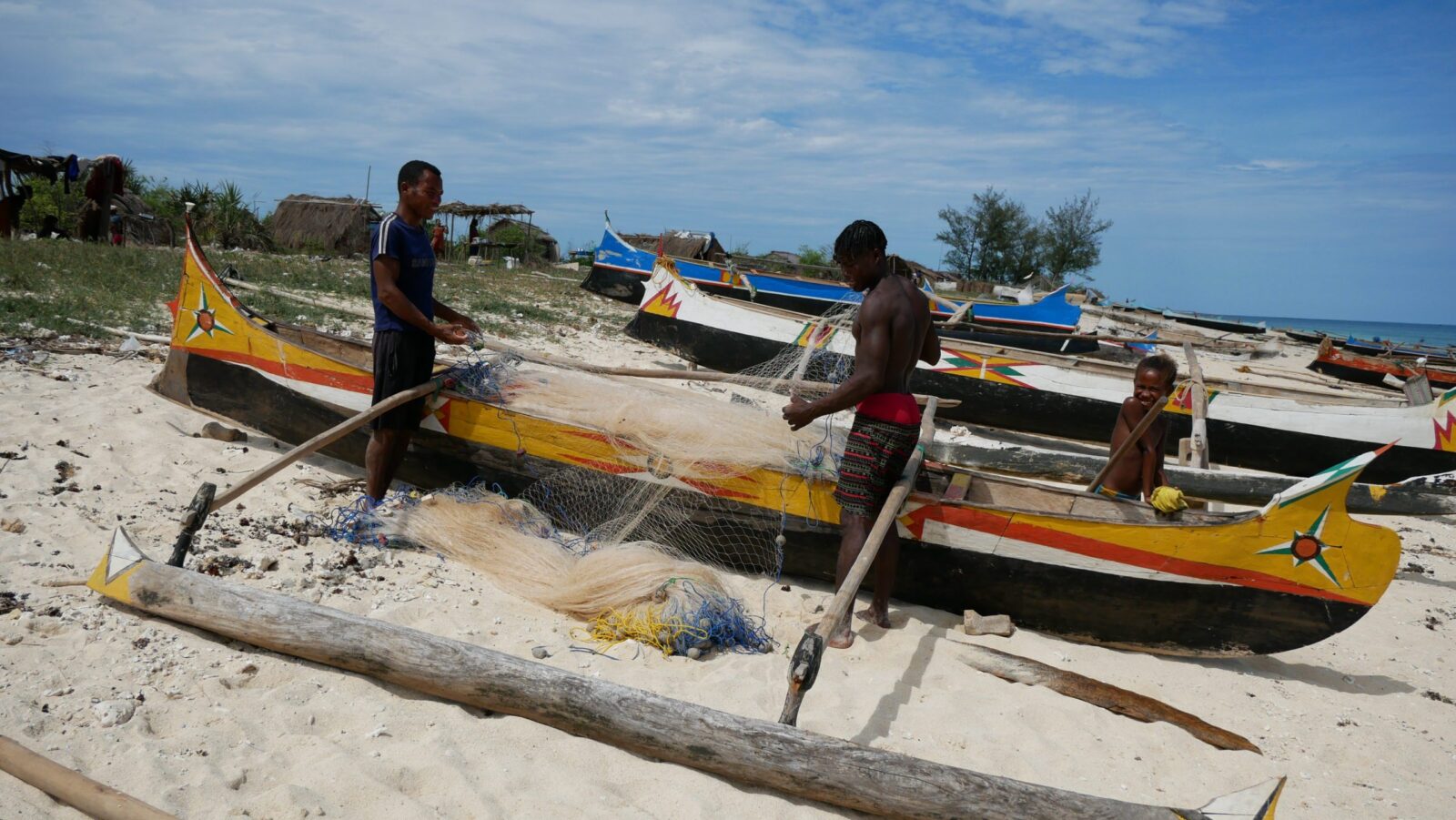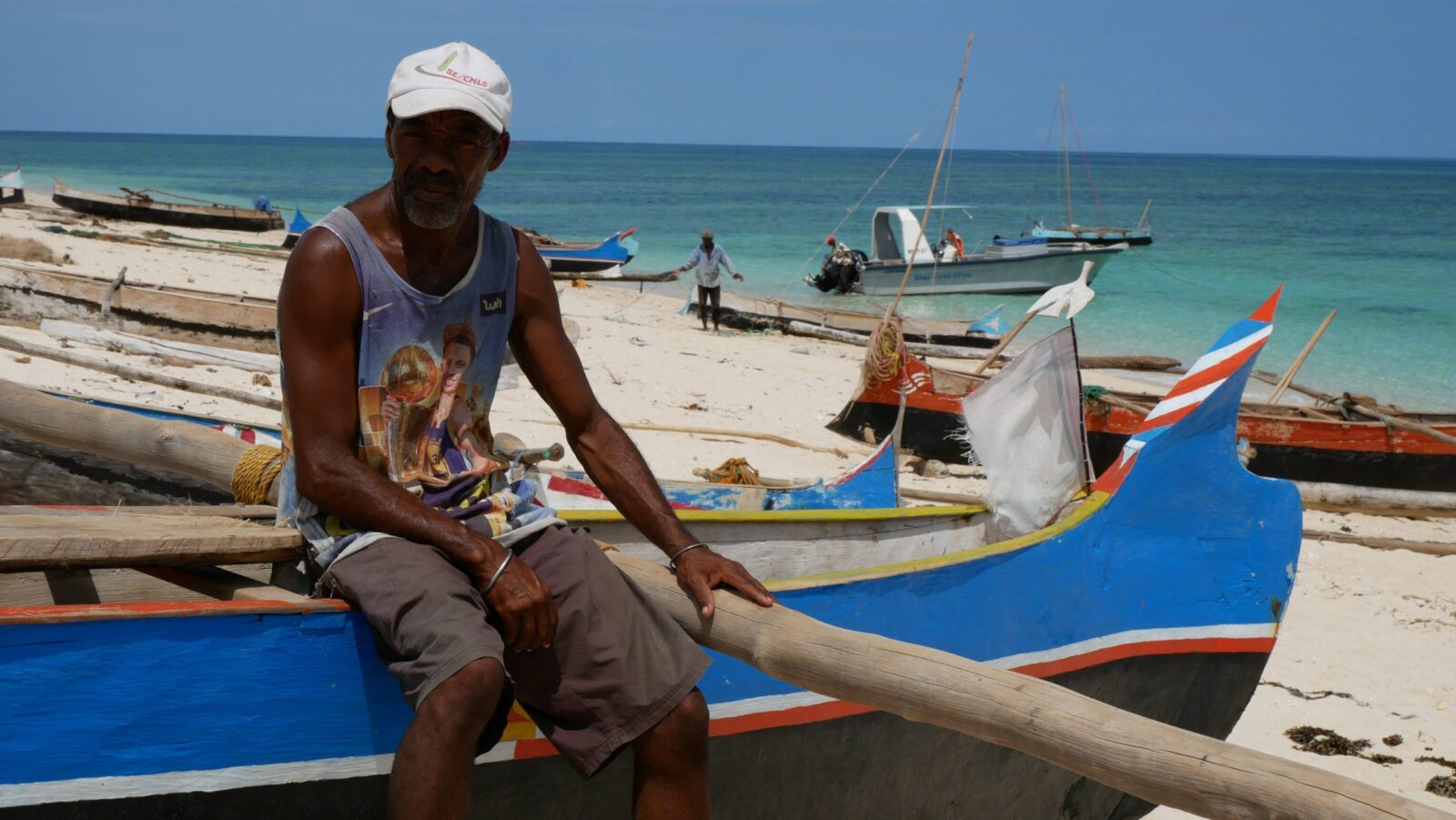This post is also available in:
 French
French
Supported by the Blue Action Fund (BAF) and the Green Climate Fund (GCF), Blue Ventures and its implementing partners, the Aga Khan Foundation, Abalobi, MIHARI, and OSDRM recently began delivering a conservation and community engagement project with communities on the Barren Isles. We spoke to Graham Ragan, the project coordinator, to find out more about the Barren Isles, the people who migrate to these tiny islands every year, and the work Blue Ventures will be supporting there.

On approach to Nosy Lava with BV skipper Tibou Solondrainy. Photo credit: Julia Vera Aga Khan Foundation.
The Barren Isles are almost like the final frontier in Madagascar. Even many Malagasy people don’t know that they exist. They’re a chain of nine small islands, about 20 to 30 kilometers off of the west coast of Madagascar. They are coral cays made up entirely of coral reefs, sand, and some small shrubbery.
Over the past two decades, the Barren Isles have become a temporary home to migratory groups of Vezo fishers and their families who had to leave their traditional fishing grounds on the west coast where fish stocks have been depleted. Out of dire necessity, they have found hope in the Barren islands where fish stocks are still plentiful. Every spring, after cyclone season, these Vezo fishers and their families make a perilous two-to three-day journey from their homes on the Madagascar mainland to the isles where they’ll often stay for up to nine months.
They are physically and metaphorically living on the edge; when we went to visit with our partners at the start of the project, we realised how remote the isles are. It took two hours from the mainland in our speedboat, which was long enough. Make that journey in the fishers’ outrigger canoes, and it will take nine to ten hours. Once you get there, the isles are really stunning. You only see ocean on the horizon, and then all of a sudden, out on the farthest tip of the horizon, you can just see some smudges finally taking shape.

Nosy Mangily community welcoming Blue Ventures, Aga Khan and ABALOBI to their island. Photo credit: Jenny Maltby, Blue Ventures.
You pull up to about ten different shades of blue in the water, you come up to the sand, and there’s a long beach with small canoes all laid out. You can see many fishers standing by their boats, maybe repairing their nets or working on their canoes. We were greeted almost immediately by the temporary residents of the Barren Isles; many had met Blue Ventures before and knew us. They sat us down and served us tea and fried sweet potato which was delicious. We had a community meeting for all of us to discuss why we were there and make a formal introduction to the community elders.

Tacia, the community president on Nosy Lava, talking to Blue Ventures, Aga Khan Foundation and ABALOBI about the challenges faced living on the island. Photo credit: Julia Vera, Aga Khan Foundation.
Stunning as they are, life on the isles is basic. There’s no sanitation system, no pit latrines, and no source of freshwater. There are no health clinics or health care systems, so accidents and emergencies can take hours, if not days, to receive medical attention. The fishers bring their families, including their very young children, and there’s no access to education, no schools. There are dozens of children on any given island. Those basic needs– water, health, education– aren’t being met.
About 500-600 people live this way. It’s hard to know the exact numbers because there is a constant movement of people going back and forth between the mainland getting supplies, staying there for a few weeks, and then coming back again. There are about 130 community members living on Nosy Lava, the largest and most populous of the islands. The other islands have anywhere from 15 to 70 people living and fishing on them.

Mamoloso, a Vezo fisherwoman on Nosy Lava next to her temporary home while she stays in the Barren Isles for fishing. Photo credit: Jenny Maltby, Blue Ventures.
Access to fresh water is a huge issue faced by communities in the Barren Isles. Most people rely on supply runs to the mainland to bring back jerry cans of water, but a one-way trip in an outrigger canoe can take a whole day depending on the weather. The island of Nosy Lava has a water catchment basin, but it’s recently developed cracks. Any time it rains, the entire community rushes to the basin with empty buckets to collect as much fresh water as possible but they are often left watching the island’s most precious resource seep through the cracks.
You may wonder: if they’ve run out of fish in their seas on mainland Madagascar, why would the Vezo fishers take such huge risks going all the way to these remote islands, why wouldn’t they just stop fishing and find something else to do? It’s a good question, with a very complex answer. For the Vezo people of Madagascar, fishing is essential to their being and their existence. It is an intrinsic part of their culture. The Vezo can’t exist without fishing, and so the decision to fish on the Barren Isles is completely tied up in that. It’s this desire to keep pursuing what gives them an identity and maybe a meaning for existence. So if there’s no fish left in their waters, the only thing to do is to keep moving and keep going further until they can carry on fishing.

The word Vezo means to paddle. Our tribe defines us and our close relationship with the ocean. Vezo is also a word used for people who dive, fish, glean, and can make and sell boats. We fish dive and glean to make a living. It’s what we think about when we first wake up, and it’s what we dream about when we go to sleep” – Symphorien Nihala Maniry Soa, Outreach Media Officer – Blue Ventures Madagascar
What is essential then for the survival of the Vezo people and their way of life is the survival of the ocean. The health of the ocean and the health of the communities who depend on it are completely intertwined, and that is where Blue Ventures enters the picture. Blue Ventures just started a five-year project supported by the Blue Action Fund and Green Climate Fund to increase the resilience of these communities to climate change and create a permanent marine protected area for the Barren Isles. Blue Ventures is not tackling this alone but is a part of an incredible consortium of partners ABALOBI, the Aga Khan Foundation, the Organisation de Soutien pour le Développement Rural de Madagascar (OSDRM), and MIHARI.

Louis and Nolavy, two fishermen on Nosy Lava, one of the Barren Isles, untangling their fishing nets after a fishing trip. Photo credit: Jenny Maltby, Blue Ventures.
The project seeks to address the issues on the Barren Isles from different angles. ABALOBI will be developing a mobile monitoring app and training community members on data collection and feedback, which will support the monitoring of key fisheries and biodiversity in the Barren Isles. The Aga Khan Foundation and OSDRM will be spearheading the livelihoods component of this project, introducing alternative livelihoods to communities so that they can supplement fishing with other income. We’re also working with MIHARI, who will be running a training programme on marine protected areas (MPAs) management, focusing on climate change and ecosystem-based adaptation (EbA) approaches to fisheries management, an important piece of the project’s advocacy work.
A major aspect of Blue Ventures’ work on the Barren Isles is raising awareness of the need to protect marine life. We want to show communities that this is not only important from an environmental perspective but also essential to the livelihoods of the migrating Vezo people. The Barren Isles has one of the most biodiverse, lively marine ecosystems in the Western Indian Ocean, and so the impetus is really there to protect and conserve it. This simply cannot happen without the participation and engagement of local communities.

Clement, a fisherman on Nosy Lava – Jenny Maltby Blue Ventures
For the longest time, the plague of the conservation sector has been ostracising and pushing out communities instead of keeping them at the centre. They’re the ones who live along the coast, who know the reefs and who spend every day on the ocean. And they’re the ones who are ultimately going to ensure whether it’s going to thrive or decline. So we need to bring in communities, government partners, and all the different stakeholders to sit at the same table and not leave out those who have historically been marginalised.

Mamoloso, Olivia, Luciana, and Selina, four Vezo women from Andavadoaka, southwest Madagascar, talking to Blue Ventures about the way they migrate to the Barren Isles at certain times of the year, depending on the weather. Photo credit: Jenny Maltby, Blue Ventures.
The organisations participating in this project are:
- Blue Ventures – Conservation and community engagement
- The Aga Khan Foundation and OSDRM – Livelihoods
- ABALOBI – Development of mobile monitoring app for data collectors on the islands
- MIHARI – MPA management training and advocacy

